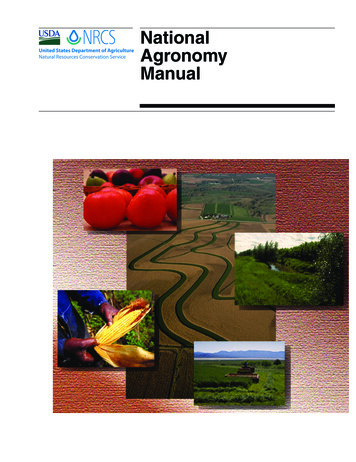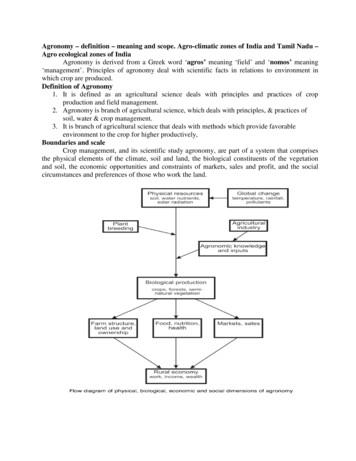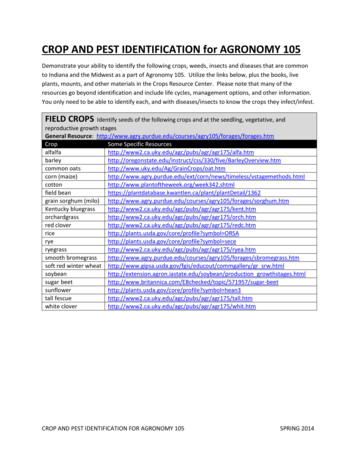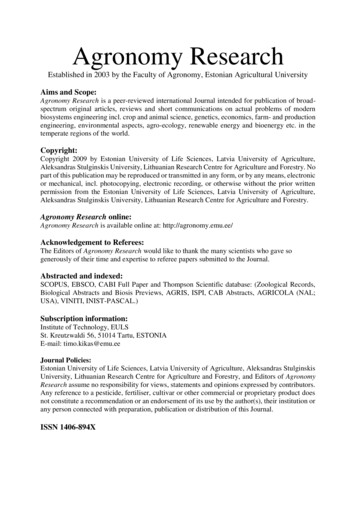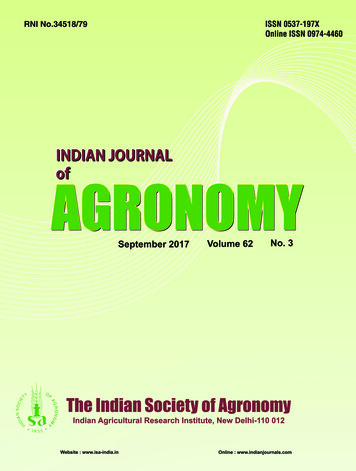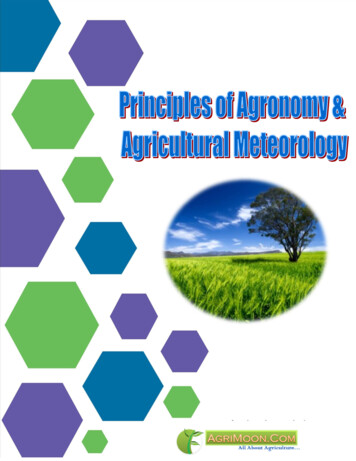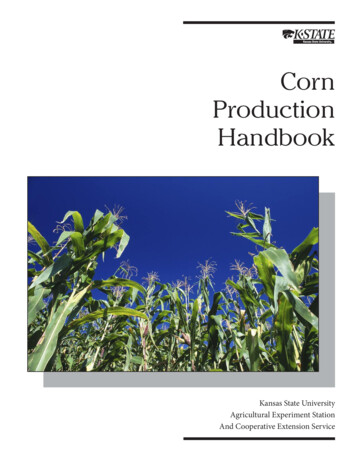
Transcription
CornProductionHandbookKansas State UniversityAgricultural Experiment StationAnd Cooperative Extension Service
Nutrient Management PhotosPhoto 1. Nitrogen deficiency (left) through nitrogensufficiency (right).Photo 2. Nitrogen sufficient (left) nitrogen deficient (right).Photo 3. Early season phosphorus deficiency.Photo 4. Late-season phosphorus response.Photo 5. Potassium deficiency.Photo 6. Potassium deficiency.Photo 7. Iron deficiency.Photo 8. Iron deficiency.
Insect Management PhotosPhoto 9. Armyworm larva.Photo 10. Black cutworm larva.Photo 11. Black cutworm damage.Photo 12. Chinch bugs.Photo 13. Corn earworm larva.Photo 14. Corn rootworm beetle.Photo 16. Goosenecked corn fromcorn rootworm injury.Photo 15. Corn rootworm damage.
Insect Management PhotosPhoto 17. European corn borer eggs.Photo 18. Fall armyworm larva.Photo 19. Flea beetle.Photo 20. Differential grasshopper.Photo 21. Maize billbug.Photo 22. Seed corn maggot.Photo 23. Southwestern corn borer eggs.Photo 24. Southwestern corn borer larva.
ContentsGrowth and DevelopmentStewart R. Duncan, Northeast Area Extension Specialist, Crops and SoilsDale L. Fjell, Northeast Area Extension DirectorRichard L. Vanderlip, Research Agromomist, Crop Production (Emeritus)3Select Hybrids CarefullyKraig L. Roozeboom, Extension Specialist, Crop Production/Cropping SystemsDale L. Fjell, Northeast Area Extension Director7Optimum Planting PracticesKraig Roozeboom, Extension Specialist, Crop Production/Cropping SystemsDan Devlin, Extension Specialist, Environmental QualityStewart Duncan, Northeast Area Extension AgronomistBrian Olson, Northwest Area Extension AgronomistCurtis Thompson, Southwest Are Extension Agronomist10Nutrient ManagementDale Leikam, Extension Specialist, Nutrient ManagementDavid Mengel, Professor, Soil Fertility and Nutrient Management14Weed ManagementDavid L. Regehr, Extension Specialist, Weed ScienceBrian Olson, Northwest Area Extension AgronomistCurtis Thompson, Southwest Are Extension Agronomist21Insect ManagementJeff Whitworth, Extension Specialist, EntomologyPhillip E. Sloderbeck, Extension Specialist, Entomology23Major Corn DiseasesDouglas J. Jardine, Extension Specialist, Plant Pathology25IrrigationDanny H. Rogers, Extension Specialist, Irrigation30Harvesting SuggestionsRandy Price, Extension Specialist, Farm Machinery36Drying and StoringJoseph P. Harner III, Extension Agricultural EngineerRandall A. Higgins, Extension Specialist, Entomology (Decesased)38Profit ProspectsMichael Langemeier, Agricultural Economist42
Growth and DevelopmentThat corn crop that you’re planning to harvest next fall,or the one you are reviewing to try to understand why yieldswere less or greater than expected, started when the seed wasplanted and ended when the ear was successfully harvested.Before planting, considerable planning and preparationgoes into corn production. The crop you hope to produce isdependent on the genetic and environmental characteristics inwhich the plant was grown.If we understand how the corn plant grows, develops, andproduces grain, we have a better chance of knowing what willaffect plant growth and consequently how to manage the cropfor best production. Consider the age of the corn in termsof plant development rather than in days. With informationregarding specific production practices, the other sections ofthis publication, will be more easily understood.Let’s start with the seed. Corn seed is made up of threeprimary parts (Figure 1): the embryo from which the newplant will develop; the endosperm or starchy part, the energysource for germination and emergence until the plant canfunction on its own; and the pericarp, or seed coat, whichprotects both the endosperm and the embryo. We want tostart with seed that has a viable embryo, that contains sufficient stored energy to get the plant established, and that hasan intact seed coat to prevent attack by disease organisms.Generally, seed is planted in soil moist and warm (mid-50degrees Fahrenheit or higher) enough to allow rapid germination and emergence. With increased adoption of no-tillageand reduced tillage farming, planting dates are earlier, onaverage, than 20 years ago. The practice of planting earlyallows for more intensified and potentially profitable cropping systems. As a result of planting early, however, corn seedis often planted into very cool soils where the 2-inch depthtemperature is often closer to the minimally acceptable (forgermination) 50 degrees Fahrenheit than the optimum mid50 degrees Fahrenheit or greater. This results in an extendedtime period to achieve emergence. Regardless of plantingdate, an average of 125 growing degree days are required foremergence (Table 1). Growing degree days are calculatedby subtracting 50 degrees Fahrenheit from the average dailytemperature, then adding the daily growing degree days overtime. The planting to emergence growing degree days shouldbe calculated from soil temperatures at seed depth.Depth of planting influences the amount of growthnecessary before the seedling can emerge from the soil surfaceand affect the time required from planting to emergence.Changes in planting depth affect the depth at which the seed(seminal) roots develop, but does not affect the depth at whichthe permanent (nodal) root system develops. Even though theseed roots anchor the plant and absorb water and nutrientsfor the first 2 to 3 weeks, the young plant is living on reservesfrom the kernel until the nodal roots develop from the crownand take over.When the collar of the first leaf (the round tipped, or“thumb” leaf ) emerges and is visible above ground, the plantis at stage V1. At that time, the seminal roots quit growing,and the nodal root system begins development. Until tasseling,the growth stage of the plant is designated by the number ofleaves with visible collars. Although six or seven leaves maybe visible on the corn plant when the collar of the fourthleaf is visible, the plant has only developed to stage V4. Fromstages V1 to V10, each new leaf will fully emerge for every85 growing degree days. From V10 until final leaf emergencerequires about 50 growing degree days per fully emerged leaf.During the first 4 to 5 weeks after emergence, the plantcontinually develops new leaves from the growing point,which, for most of this period, is below or at ground level. Atotal of approximately 20 leaves will be developed. Duringthis time, root and leaf development progress rapidly. Nutrientuptake also is occurring rapidly. Since the growing point is stillbelow the soil surface, a frost or hail may destroy the exposedleaf area, but likely would not kill the plant. This could beFigure 1. The primary parts of a corn seed.Table 1. Approximate Growing Degree Days (GDD)required for a mid-season maturity corn hybrid to reachdifferent growth stages from the time of planting1.PericarpStageVE - EmergenceEndospermV6 - Tassel initiationEmbryoGDD125475VT - Tassel emergence1,150R4 - Dough stage1,925SilkingR5 - Dent stageR6 - Physiological maturity or black-layer1,4002,4502,700Adapted from R.G. Hoeft, et al. 2000. Modern Corn and SoybeanProduction. Page 8.1
particularly important when determining whether or not toreplant following a late-spring frost or hail storm.At stage V5 to V6 about 475 growing degree days, all ofthe leaves the plant will produce have started, the growingpoint changes and the tassel is initiated (Table 1). Ears areinitiated shortly after the tassel. By growth stage V6, thenodal roots have become the main root system of the plant.Within a few days of tassel initiation, the stalk grows rapidlyand the growing point is elevated above the soil surface whereany damage could affect the growing point and kill the plant.During the following 4 to 5 weeks, rapid growth occurs withthe remaining leaves increasing in size and producing the“factory” that produces the grain during the latter portion ofthe growth cycle.During this period of rapid stalk growth, plant heightincreases dramatically, the developing tassel emerges (1,150growing degree days - Table 1) from the whorl and continuesdeveloping until pollination occurs. Rapid root development andnutrient uptake also occur so that at tasseling, less than half of thefinal weight of the corn plant has been developed. However, morethan 60 percent of the nitrogen, 50 percent of the phosphorus,and 80 percent of the potassium have already accumulated in theplant. The grain producing capability of the plant is set/determined during this particularly important time period.During the flowering process, stress conditions have moreeffect on the timing of tassel development than they have onear development. Under hot, dry stressful conditions, the tasselmay develop and shed pollen before the ear and silk formationhas been completed resulting in poor or incomplete pollination. Silks will grow slowly and fail to emerge in time to bepollinated as well as being too dry to support pollen germination and the complete growth of the pollen tube. One day ofmoisture stress (Figure 2) within a week after silking (1,400growing degree days - Table 1) can result in up to 8 percentyield losses. A period of 3 to 4 days of severe moisture stress atthis time can easily reduce final grain yields by 30 percent. Thepollination process begins at the base of the ear and progressesto the tip. By looking at pollination problems on various earsections/zones, the timing of the problem can be determined,Use of Growing Degree Unitsin Corn ProductionDays After PlantingRange of measuredyield loss from stressAverage yield lossper day of stress 140For years, corn maturity has been labeled in days. A 120day variety would presumedly reach maturity 120 days afterplanting. This system does not take into account complicatedphysiological processes that control growth and development ofcorn. The number of days required to reach maturity dependson location and date of planting, and theweather to which the plant is subjected in aparticular growing season. In most years, thegrowing season will be more or less than 120days. The decision as to which hybrid to plantto attain maximum production, based onmaturity can be difficult. A delayed plantingmight not provide the required number ofdays for the selected hybrid to fully mature.Or, the selected hybrid may be at a criticaldevelopmental stage(s) during periods ofenvironmental and/or climatic extremes. Earlyplanting dates should allow your selectedhybrid to reach maturity with time to spare,but again, if the plants are stressed during keyreproductive stages yields may be devastated.1301201101009080706050% Yield Loss per Day StressFigure 2. Corn yield loss due to one day of moisture stress.98765432Silking10and in many cases the event that led to the poor timing isclearly identified.The final stage of growth of the corn plant is one thatresults in grain production. Beginning at pollination, essentially all of the carbohydrates produced by the plant go intothe developing kernels. The amount of production that occursis determined by 1) the potential set during the early stages ofdevelopment; 2) the size of the “factory” that developed duringthe middle portion of the growth of the plant; and 3) theproduction of the plant during the final stage of the growthcycle. Drought or nutrient deficiencies during this period willresult in unfilled kernels and light, chaffy ears.Approximately 50 to 60 days after pollination (2,700growing degree days - Table 1) most corn hybrids will reach“physiological maturity” or “black-layer.” The grain fillingprocess ends and the dry weight of the grain no longerincreases. This does not mean that the grain is at a moisturecontent suitable for harvest. Physiological maturity occursin the 25 to 35 percent moisture range, depending on hybridand environmental conditions. After black-layer, grain dryingis entirely a matter of moisture loss. If you can use or markethigh-moisture grain, or you want to harvest early and dry thegrain, harvest can occur any time after black-layer without anyreduction in total dry weight of grain harvested.If you consider effects of various management practiceson each of the three major periods of corn plant development,you will be able to see how these practices can affect the yieldof your corn crop. Similarly, if some unexpected problem arisesand you can relate this problem to the normal growth anddevelopment of the corn plant, you will have a better understanding of how this might affect your final yields.
Each day does not contribute equally to the growth ofplants. Growth is faster during the warm season than in coldweather. On the other hand, summer temperatures can betoo high for optimum growth. Although factors other thantemperature enter into determining rate of growth, seedproducers use the temperature based growing degree daysconcept to express hybrid maturity. Over the years, many“heat-unit” systems have been devised. The one currently inuse for corn was proposed by the Environmental Data Serviceof the National Oceanic and Atmospheric Administration(formerly U.S. Weather Bureau).In this system, 50 degrees Fahrenheit is the base temperature. Growing degree days are calculated by subtracting thebase from the average daily air temperature. Corn grows verylittle at temperatures below 50 degrees Fahrenheit. Untilthe leaves emerge from the soil, use of the average daily soiltemperature at seed depth rather than air temperatures isrecommended to more accurately calculate growing degreedays. As the temperature rises, corn grows faster if moisture,and nutrients, are plentiful. However, at air temperatureshigher than 86 degrees Fahrenheit, plant roots have greaterdifficulty taking in water fast enough to keep the plantgrowing at full speed. Growing degree days are calculated bythe following equation:Max Temp. Min Temp.GDD – 50 F2Figure 8598Maturity (early)ColbySilking (full)Garden Cityand HortonSilking ptOctGDU’s Required to Reach:Early Season VarietyFull Season VarietySilkingMaturity1,3901,5602,6102,830the broad mid-range of conditions in the state. Interestingly,a northern station at a low elevation (Horton) has about thesame conditions for promoting growth as a southern stationat a higher elevation (Garden City). Elevation and latitudecombine to determine the length of the Kansas growingseason. Independence data represents the area of southeastKansas that has a relatively long growing season. Periods ofsummer heat are more critical for corn production in this areathan the chances of an early freeze.Suppose you are considering selecting one of the twohybrids rated by the seed supplier as shown in Figure 3.Further, let’s assume that soil temperatures will warm to favorable planting levels at about 400 growing degree days afterMarch 1. By following the Planting Date line, we can determine the average date at each location when this will occur.Naturally, southeast Kansas (April 22) will reach the pointsooner than at Garden City (May 1) or at Colby (May 7).If you are able to plant when 400 growing degree dayshave accumulated, the seed supplier predicts that the earlyhybrid will silk after 1,390 additional growing degree dayshave accumulated (1,790 total growing degree days). Thefuller season hybrid will not silk until a 1,960 total growingdegree days have accumulated. The silking stage is crucial forthe production of high corn yields. You can reduce the risk ofyour corn reaching silking at the time when moisture and hightemperature stress are most likely. Corn producers in your area,578Maturity (full)2,500Table 2. GDD accumulations calculated for some highand low daily temperatures.MinimumIndependence4,000Minimum temperatures below 50 degrees Fahrenheit arecounted as 50 degrees Fahrenheit and temperatures above 86degrees Fahrenheit are counted as 86 degrees Fahrenheit.The average growing degree days accumulation beginningon March 1 for four sites are shown in Figure 3. Use the accumulations to understand how growing degree days can be usedto help plan your corn operation. Notice that the accumulationrate is very slow early in the season, then increases rapidly andfinally slows down again near the end of the growing season.This variable rate of accumulation is what makes maturityexpressed in days inconsistent. Planting 1 week early mayresult in corn reaching maturity only 1 day earlier.The three curves in Figure 3 represent the growingconditions throughout the state. Colby represents the highelevations in northwest Kansas that have a relatively shortgrowing season. The Garden City-Horton curve representsDaily Temperature, Degrees FEnd of Season2224
the end of season mark on each curveindicates the date 10 days prior tothe average 32 degrees Fahrenheitfreeze date. Note that neither hybridutilizes the entire growing season in20southeastern Kansas. Perhaps youmight want to try a hybrid that requires2510almost 3,000 growing degree days toreach maturity. Remember however,25mid-season hot spells affect pollination.In northwestern Kansas, and in west25central Kansas, full season corn that hasa requirement of 2,800 or more growing15degree days may not reach maturity20before a killing freeze. The early seasonhybrid certainly looks to be more prom2525 25 20202525ising in this area.especially dryland growers, should pay particular attention toThe example given above assumes aselect a rating and planting date that will fit your environment.normal year, and planting on schedule. What if your plantingIf we add the predicted number of growing degree daysis delayed 1 week, or even 2 weeks? Your decision will dependneeded to reach maturity to our assumed planting dateon your location, but you might want to change corn hybrids.accumulation of 400 growing degree days, we can predict theAnother factor to consider is that the curve represents normaltime when the crop will be ready for harvest. Earlier planting(or average) conditions. As everyone knows, such conditionsdates, earlier maturing hybrids and the use of starter fertilizerdon’t often exist. These curves can still be useful if they arehave all contributed to crop physiological maturity and harvestshifted to fit the actual conditions on a particular date. Forbeing well ahead of the prospects of an early freeze, unlessexample, Figure 3 shows that between March 1 and May 27,planting is abnormally delayed. In our example, however,Figure 4. Average date of first 32 degree Fahrenheit freeze in fall. All dates are inOctober10105510 sSheridanGrahamRooksOsborneTr i eRile yJackso nJe fferso n LVOttawaWa llaceLoganGov eLincol eeleyWichitaScot rantGreenwoodWoodsonAllenWilso nNeoshoMontgomeryLabetteBourbonSedgwickPrat tHaskel lAnderso n LinnHarveyEdwardsFor dStantonMiamiChas eStaf fordRenoGrayFranklinLyonMario nCof feyHamiltonJohnsonOsageMorrisBartonMcPherso MeadeClar eTable 3. Growing degree units from this date to end of seasonAshlandBellevilleBurr OakColbyElkhartEmporiaGarden iManhattanMcPhersonMedicine LodgeMinneapolisOttawaQuinterSt. 62,8132,5253,441End ofSeason*Oct. 14Oct. 3Sept. 30Sept. 28Oct. 8Oct. 10Oct. 7Oct. 5Oct. 6Oct. 13Oct. 17Oct. 15Oct. 11Oct. 10Oct. 7Oct. 12Oct. 17Oct. 8Oct. 12Oct. 13Sept. 25Oct. 1Sept. 25Oct. 16* End of season date is defined as 10 days before the average date of first 32-degree Fahrenheit freeze in fall. There is a 20 percent chance that afreeze will occur before this date.
1,000 growing degree days accumulation at Independenceis normal. What if the spring is cool and growing degreedays doesn’t reach 1,000 until June 7? If you assume normalconditions the rest of the year by shifting the curve so thatthe 1,000 growing degree days level is reached on June 7, youwill again have a prediction of the growth and development ofyour corn crop for that particular year.Table 3 lists the number of growing degree days that willbe available on average for various planting dates for a numberof Kansas locations. We assume that the growing season ends10 days prior to the average date of the first freeze in the fall.The probability that a freeze will occur before that date is onlyone in five or 20 percent. Figure 4 shows the average date ofthe first 32 degrees Fahrenheit freeze across Kansas.If you plant corn in the Tribune area on May 2, you canexpect to have a seasonal total of 2,786 growing degree daysfor your crop. You should select a hybrid that has a requirement less than this. Keep in mind that the number of growingdegree days will vary from year to year. The totals will bewithin 150 growing degree days above or below the valueslisted in Table 3 in 70 percent of the years.The growing degree days rating placed on corn hybridsby seed producers can give you a great deal of insight into thegrowth and development of your crop. Getting familiar with, andusing the growing degree days system will be worth your effort.Hybrid SelectionHybrid Development and Marketingstorage capacity, slope, insect and disease potentials, etc.),and each manager has unique financial, labor, and equipment resources available to address these limitations. Otherproduction decisions also play a role in determining whatkind of hybrid is needed. For example, an early maturinghybrid may give disappointing yields under full irrigation,heavy fertilization, and a long growing season. Conversely, afull-season hybrid may not do well on a nonirrigated site withlower potential fertility that tends to run out of soil moisturein August. The corn producer’s challenge is to choose hybridsappropriate for each management situation, keeping in mindrisks associated with potential weather extremes.Private firms market nearly all hybrid seed sold to cornproducers. Some of the larger companies have highly trainedbreeders and actively develop unique inbred parent lines.Many other firms use inbreds released by public institutionsand/or parent lines and crosses provided by private seedproduction specialists. As a result, the same or very similarhybrids may be marketed by several companies.During the past decade, a number of novel traits havebeen incorporated into hybrids. Some of these traits wereintroduced using traditional plant breeding methods. Otherswere transferred from other species using genetic transformation techniques. Currently, the most important of these noveltraits are related to insect resistance and herbicide tolerance.Most seed companies have suites of these traits available aloneor “stacked” in various combinations in a range of geneticbackgrounds. Be aware of potential market restrictions associated with some traits.Few, if any, public institutions actively develop hybridsfor public use, but several have research programs that furnishindustry with basic research information, diverse gene sources,and improved inbred lines. Public scientists often have skillsand resources unavailable to private firms, while industry canproduce and market quality seed in a much more efficientmanner than public agencies. Intense market competitionensures the steady introduction of improved hybrids developedby the combined efforts of private and public scientists.Information SourcesImportance of Choosingan Appropriate HybridChoosing an appropriate hybrid is essential for successfulcorn production. University hybrid tests often have a yieldspread of 25 to 30 bushels per acre between the top-yieldinghybrids and the test average. Poorly adapted hybrids may yield50 or more bushels per acre less than the best hybrids. Eachfield has unique limitations (soil fertility, moisture intake and Personal experience with a hybrid is the final test ofsuccess; however, narrowing the list of available hybrids tothose best suited for your unique situation requires siftingthrough a large amount of information. Corn producersshould use all available information when selecting hybrids.Seed companies often do a good job of characterizing theirhybrids, especially in comparison with the other hybrids intheir product line. Company strip tests can be powerful whendirect comparisons are made over a large number of tests.University performance tests provide the opportunityfor a large number of direct comparisons between hybridsfrom a wide range of companies at a number of locationsacross the state. K-State Research and Extension publishesan annual Report of Progress including detailed results frommore than 20 Kansas Corn Performance Tests conducted atseveral sites. The same information is available electronicallyat http://kscroptests.agron.ksu.edu. Often, test results are postedon line within a few days of harvest. Seed companies participate voluntarily on a cost-sharing basis by paying a fee foreach hybrid entered in each test. The program has evaluatedseveral thousand different hybrids since its inception in 1939.Tests do not include all hybrids grown in the state and do notinclude the same set of hybrids at all test sites because entrants
choose where to enter their hybrids. However, test resultscontaining current-year summaries and multi-year averagescan provide considerable guidance toward wise hybrid choices.so few hybrids tested in more than one year, it becomes difficultto accumulate the information needed to make informed selection decisions. This rapid turnover underscores the need forannual examination of hybrid performance at several locations.Hybrid Responseto Changing EnvironmentsTraits of InterestYield and Lodging — All other things being equal, acorn producer wants the highest yielding hybrids available.Lodging can severely decrease yields under certain conditions.If so, high yielding hybrids with superior stalk quality understress conditions are most desirable.Maturity — Choosing the appropriate maturity foreach situation is fundamental to choosing the right hybrids.Relative maturity is rather clearly defined and predictablebased on either private company or experiment station information. Problems may arise when comparing similar hybridsfrom different companies using their maturity ratings becausethe industry has no standardized maturity reporting system.State trials are a good source of information on relativematurity by reporting silking dates and harvest moisture for allentries in a given test. Once you choose the desired maturity— early, midseason, or full-season (for your area) — you cansort among hybrids within that class for other characteristicsthat fit the intended purpose.A hybrid attains physiological maturity when dry matterstops accumulating in the grain (somewhere between the 25percent and 35 percent grain moisture levels). Safe storagerequires further drying. To lower the risk of experiencing softcorn and yield reduction problems when using full-seasonhybrids, choose those that reach physiological maturity at least1 or 2 weeks before the average date of the first killing frost inyour area.Deciding which maturity class to plant depends on anumber of factors unique to each field. With favorable moisture, temperatures, and fertility, full-season hybrids generallyproduce the highest yields. However, early and midseasonhybrids may be a wise choice if some of the production factorsare limiting, for example on non-irrigated, upland sites withpoor water-holding capacity. Many mid-maturity hybridshave excellent yield potential under favorable conditions. Earlymaturing hybrids are useful for later plantings, for fields thatyou wish to fall-pasture or till before winter, or for other specialsituations. Early maturing corn may be an alternative to grainsorghum or other crops on somewhat marginal land if it canbe planted early, if it can set and fill seed before late summerheat and drought stress become severe, and if the producer iswilling to assume a slightly greater risk. Harvesting these plantings promptly will minimize lodging losses. Plant populationsshould be adjusted to match the requirements of each hybrid.Early hybrids often perform better when planted at populations higher than those normally used for full-season hybrids.Planting several maturities over a several-week period providesinsurance against severe weather losses, and if done carefully,spreads harvest over a longer period.Corn production in Kansas encompasses a wide range ofenvironmental conditions. A strong rainfall gradient exists generally east to west across the state. Soil texture varies from heavyclays to loose sands. Soil depth changes dramatically from onearea to another. Length of growing season generally decreasesfrom south to north and east to west due to latitude and elevationchanges. Cropping system factors such as irrigation, tillage, croprotation, and fertility regimes come into play as well.Analysis of
Photo 17. European corn borer eggs. Photo 18. Fall armyworm larva. Photo 19. Flea beetle. Photo 20. Dif
